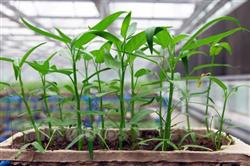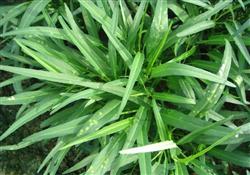Asparagus and its cultivation points

Ipomoea aquatica, also known as Ipomoea aquatica, Ipomoea angustifolia and Ipomoea aquatica, is an annual or perennial vine of the family Spirulaceae. Asparagus is eaten with tender stems and leaves. Asparagus has a long harvest time and is a leaf vegetable growing in summer, which can make up for the market structure of less-leaf vegetables and more fruit vegetables in summer in Liaoning Province. Hollow cabbage has a strong branching ability to extract tender shoots from leaf axils, which can be picked many times and is not limited by high temperature and rainstorm. First, botanical characteristics and cultivation characteristics. Asparagus, with shallow whisker roots, strong regeneration ability, short flat or nearly round stem nodes, hollow, dark green to light green. Cotyledons opposite, horseshoe-shaped, true leaves alternate, long ovate, basal leaves heart-shaped or lanceolate, entire, smooth, dark green or light green. Leaves 13-17 cm long, 8-10 cm wide, petiole 12-15 cm long, hollow concave. The seeds are nearly round, the skin is thick, dark brown, and the weight of a thousand seeds is 32-37 grams. Asparagus propagates by seed or tender stem. Asparagus prefers high temperature and humid environment. It takes more than 15 ℃ for seed germination, and the optimum temperature for vine leaf growth is 25-30 ℃. When the temperature is higher, vine leaf growth is more vigorous, and the picking interval is shorter. Puccinellia oleifera can withstand the high temperature of 35-40 ℃, the vine leaves below 15 ℃ grow slowly, the vine leaves stop growing below 10 ℃, are not resistant to frost, and the stems and leaves die in case of frost. Asparagus prefers high air humidity and moist soil, the over-dry vine fiber increases, and the edible quality decreases. Asparagus also likes to have plenty of sunshine, but it also has strong adaptability to close planting. The soil with higher sticky weight and strong water and fertility conservation is better, which requires a large amount of fertilizer and strong fertilizer tolerance, especially for nitrogen fertilizer. Second, variety. ⑴ white flower species: long heart-shaped leaves, hypertrophic stems and leaves, light green, white flowers, tender texture, good quality. Such as big bone blue, big chicken white. ⑵ purple flower species: lilac stems and flowers, many fibers, poor quality, strong stress resistance. ⑶ Jian big-leaf water spinach: suitable for loam or clay cultivation, like nitrogen fertilizer, luxuriant stems and leaves, hollow nodes in stems, hypertrophic leaves, high yield and good quality, strong adaptability. Third, main points of cultivation. The yield of hollow cabbage depends on the number of picking and the weight of each picking, while the increase of picking times and each harvest mainly depends on the three key links of "early planting, more fertilization and diligent picking". 1. Site selection: spinach is suitable for humus-rich and moist soil, with strong branching, well-developed adventitious roots, rapid growth, high cultivation density, high harvest times, high yield and fertilizer tolerance. Therefore, we should choose sunny, fertile, water-source fields to plant. The effect of cultivation in protected soil is better. 2. Sowing: the open field in central Liaoning is generally sown in the middle of April, using strip sowing or on-demand sowing, and the seed consumption per mu is 15 kg. The sowing date of protected cultivation can also be advanced accordingly. 3. Field management: from cotyledons to 4-5 leaves, the optimum temperature is 20-25 ℃. The suitable temperature in the growing period of stems and leaves is 25-35 ℃, and the light conditions are not strict. There is a great demand for water and fertilizer, in addition to applying sufficient base fertilizer, but also a large number of topdressing, each picking topdressing 1-2 times, the concentration of topdressing should be light and then concentrated, mainly nitrogen fertilizer. Drought and lack of fertilizer will affect the yield and quality. The harvest of hollow cabbage, such as one harvest, the plant height of 12-15 cm can be interspersed with seedlings. If it is harvested many times, it can be pulled out and listed in combination with fixed seedlings when the plant height is 18-21 cm, and the row spacing is 12-15 cm. The seedlings left behind can be harvested and listed many times. When the plant height is 33 cm, the first picking begins, and two stem nodes are left at the base of the stem. In the second picking, the second segment left at the base of the stem was picked. In the third picking, the first stem left at the base of the stem was picked to reach the base of the stem to sprout again. In this way, the stems picked in the future can be kept stout. It is appropriate to pick by hand when picking, and it is easy to rust and die if you use iron tools such as knives to harvest. 4. Pest control: there are Plutella xylostella, red spiders, aphids, leaf rollers and other pests in hollow vegetables, which should be controlled in time. The disease is mainly caused by white rust, which can be controlled by spraying 1-D-1-D-1-1-D-1-D-1-
- Prev

How to apply fertilizer to asparagus
Asparagus is not strict on soil, but the soil with sufficient water and fertilizer and strong water and fertility is more advantageous. Asparagus vine leaves grow rapidly, requiring a large amount of fertilizer and strong fertilizer tolerance. If there is sufficient fertilizer and water, high quality and high yield can be obtained, but fertilizer and water should be controlled in the planting land, otherwise it is easy to grow and not blossom. The basic fertilizer of asparagus is soil manure and manure.
- Next

What to do if hollow vegetable suffers from white rust
① selected disease-free seeds or mixed seeds with 0.3% seed weight of Manganese Zinc. ② the disease is only limited to infect Convolvulaceae vegetables. After 2-3 years of rotation, the disease control effect is good. ③ should pay attention to the discharge of stains in the field and ventilation of sparse plants. ④ sprayed 48% metalaxyl manganese zinc wettable powder and 40% metalaxyl copper wettable powder at the initial stage of the disease.
Related
- Where is it suitable to grow horseradish in China? it is expected to see the middle altitude horseradish in Alishan.
- How to prevent tomato virus disease reasonably? (Control methods included)
- Many people like to plant towel gourd on the balcony. What are the main points of this method and management?
- What crops can chili peppers be mixed with?
- Fertilization techniques and matters needing attention in Tomato
- What are the grafting techniques for peach seedlings in spring?
- Harm and control methods of root swelling disease of Chinese cabbage
- What are the pests of sweet potatoes? How to prevent and cure it?
- Symptoms, causes and Control methods of navel Rot in Tomato
- The cause of "Cucumber rotten bibcock" in Farmers' planting Cucumber and its Control Plan

